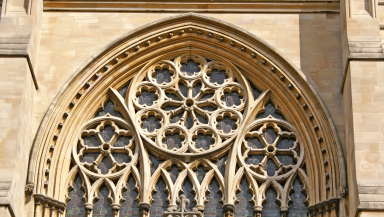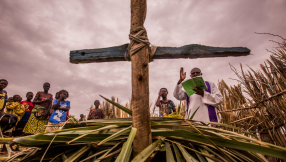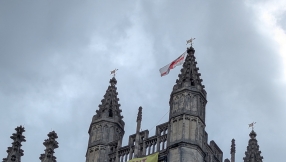
Few people know that there was once a Pope from England. This is the story …
Background
The Normans had invaded England in the eleventh century. They spoke Norman-French, while the local people spoke Anglo-Saxon which became modern English. The Normans built great castles, and many still stand today. They replaced many of the Saxon church buildings with grander Norman ones and built abbeys and monasteries. The language of the Church at the time was Latin. This period was documented by William of Newburgh who wrote Historia rerum Anglicarum. This was a history of England from 1066 to 1198, written in Latin, and translates as “The History of English Affairs”. In this book he tells the story of Nicholas Breakspear the only Englishman to become a Pope.
Nicholas Breakspear
Nicholas Breakspear is believed to have been born around the year 1100 AD in Bedmonton (now called Bedmond), a hamlet in the parish of Abbotts Langley near Watford in Hertfordshire. The house where he was born became known as Breakspear Farm, and the Breakspear family attended the local Saxon church at Abbots Langley. The farmhouse was later converted into cottages, and remained a place of pilgrimage until the 1960s, when it was demolished to make way for a small crescent of modern houses, where Bedmond Road meets the High Street.
Education
Nicholas was educated at the Abbey School in St Albans, whilst his father Robert worked as a clerk at the Abbey. After his mother died, his father enrolled as a Benedictine monk at St Albans Abbey. The story goes that Nicholas asked the Abbot if he too could become a monk. The Norman abbot Richard d’Albina (1097-1119) told Nicholas he was too young and asked him to stay at the school and wait until he was ready. Nicholas did odd jobs around the monastery to be near his father. His father found this embarrassing, and the Abbot of St Albans asked Nicholas to keep away from the monastery.
Travel to France
Nicholas left St Albans and travelled to France to continue his education. He is supposed to have studied law in Arles, on the south coast of France, and then joined the nearby St Rufus Augustinian monastery near Avignon. He seems to have excelled because shortly after joining he was made a canon Provence and then was elected as the abbot in 1137. In that role he had to travel to Rome, where he met Pope Eugene III. In 1146, Nicholas was made Bishop of Albano in Rome, and a Cardinal.
Papal Legate
The Pope made Nicholas Breakspear a Papal Legate to represent the Pope. He organised the Church in Catalonia after the defeat of the Saracens. In 1151, he was sent to Scandinavia to bring the Gospel to pagan areas of Norway and Denmark and achieve peace between the different warring kings. In 1152, Breakspear established the Archdiocese of Norway at Nidaros, Trondheim, which covered Norway, and Norse settlements in the Faroe Islands, Orkney Islands, Iceland, and Greenland and granted it independence from the Church in Germany. He then travelled onto Sweden where he was extremely popular, and he oversaw the sending of missionaries into Finland.
Becoming Pope
On his return to Rome he was hailed as the Apostle of the North. Shortly afterwards in December 1154, Pope Anastasius IV died. At that time, all the Popes had been high ranking and Italian. Nevertheless, despite his humble upbringing, and probably due to the high esteem he had earnt, later that month Nicholas Breakspear was unanimously elected Bishop of Rome, commonly known as the Pope. Nicholas Breakspear loved the story of the first British martyr St Alban. It is said that he chose the name of Hadrianus Quartus (Adrian IV) in honour of the eighth century Pope Adrian I, who had canonised St Alban and granted privileges to St Albans Abbey. In 1154, Pope Adrian IV elevated St Albans Abbey as the premier Abbey in England, a position it held until the Dissolution of the Monasteries in 1539.
Politics
Adrian IV reigned as Pope for only four years, which were years of turmoil. Adrian IV believed that the Pope held ultimate authority to assign territories, and that the kings of Catholic Europe owed him allegiance, which led to clashes with the rulers of the day. He restored Papal authority over the city of Rome, and clashed with the Holy Roman Emperor Frederick I Barbarossa over authority, and with the Byzantine Emperor over territorial claims in the Adriatic.
Ireland
Ireland was a centre of Celtic Christian learning and Irish monks had spread Christianity through Europe. In mediaeval times it had a looser relationship with Rome, with customs and practices out of synch with continental Europe, and it did not pay an annual tax called Peter’s Pence to Rome. Now he was Pope, Adrian IV was unable to go to Ireland himself, like he did to Scandinavia, so about 1158, Pope Adrian IV gave and granted the governorship of Hibernia (Ireland) to the king of England with the authority to reform the Church in Ireland.
The papal bull (decree) was called Laudabiliter. In 1171, King Henry II used this papal bull to justify his Anglo-Norman invasion of Ireland. The bull has proved controversial. No known copy of the bull has survived, so the exact wording cannot be checked. This has led to some historians to argue that it might have been fabricated, although it does chime with Pope Adrian IV’s views of Church governance and politics.
Pope Adrian IV could not have foreseen the consequences of Laudabiliter, whether genuine or not. English kings up until the Reformation based their title of ‘Lord of Ireland’ on the authority of this papal bull, which laid the groundwork for English colonialism in Ireland, and the dominance of the Catholic Church in Ireland.
Reforms
It was said that despite the problems, Adrian IV was kind and just, acting with dignity and strength. One of his reforms to the feudal system was to establish the principle that serfs could freely and lawfully marry without the consent of their lords. He also looked kindly on parish priests by allowing them to keep part of the parish tithe money to support them.
Death
Pope Adrian IV died in Anagni, Italy, on September 1, 1159, having been Pope since 1154. He was buried in the crypt of St Peter’s Basilica in Rome, along with other popes. The plaque above the stone tomb reads in Latin ‘Hadrianus Papa IIII’. His death led to divisions in the Church, with a disputed papal election that resulted in a period of several rival claimants to the papacy until 1181.
Memorials
In 1484, when a stone mediaeval altar screen was added to St Albans Abbey they included a statue of Pope Adrian IV, which looks down on the tomb of his father, Robert, who is buried with the early abbots.Today as you drive into Bedmond the sign says “Bedmond Village – Birthplace of Pope Adrian IV”, where the location is marked by a concrete plaque on a grass bank. Inside the parish church at Abbotts Langley, which Nicholas Breakspear attended, a plaque was erected by the Hertfordshire Historical Association in 1924. It reads “At Bedmond in this parish about the date of the building of this present church was born Nicholas Breakspear Pope Adrian IV (1154-1159) the only English Pope.” A new room on the north side of the church with kitchen and toilets was called the Breakspear Room.
Abbotts Langley has streets called Adrian Road, Breakspear Road and Popes Road, and in Hemel Hempstead there is a road off the M1 called Breakspear Way and a business office park called Breakspear Park. The Catholic community remembers him better. In 1963, a new Catholic church was built at Abbots Langley called St Saviour’s, which is home to a large bust of Pope Adrian IV, and nearby in St Albans there is a Nicholas Breakspear Catholic School.
Adrian IV was the first, and so far, only English Pope.













